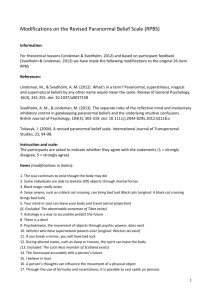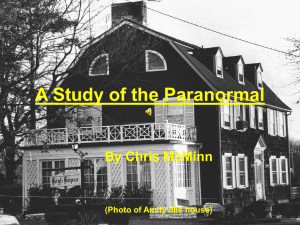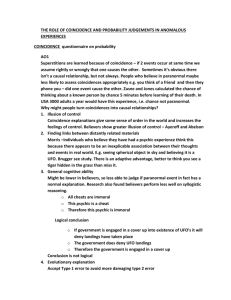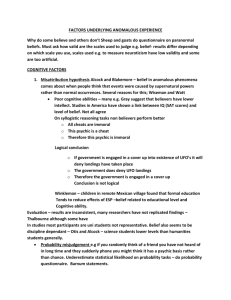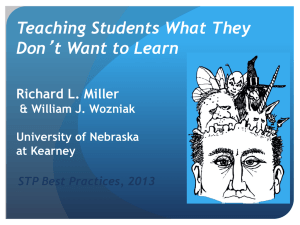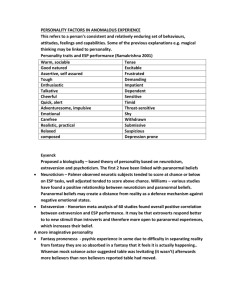A Revised Paranormal Belief Scale
advertisement
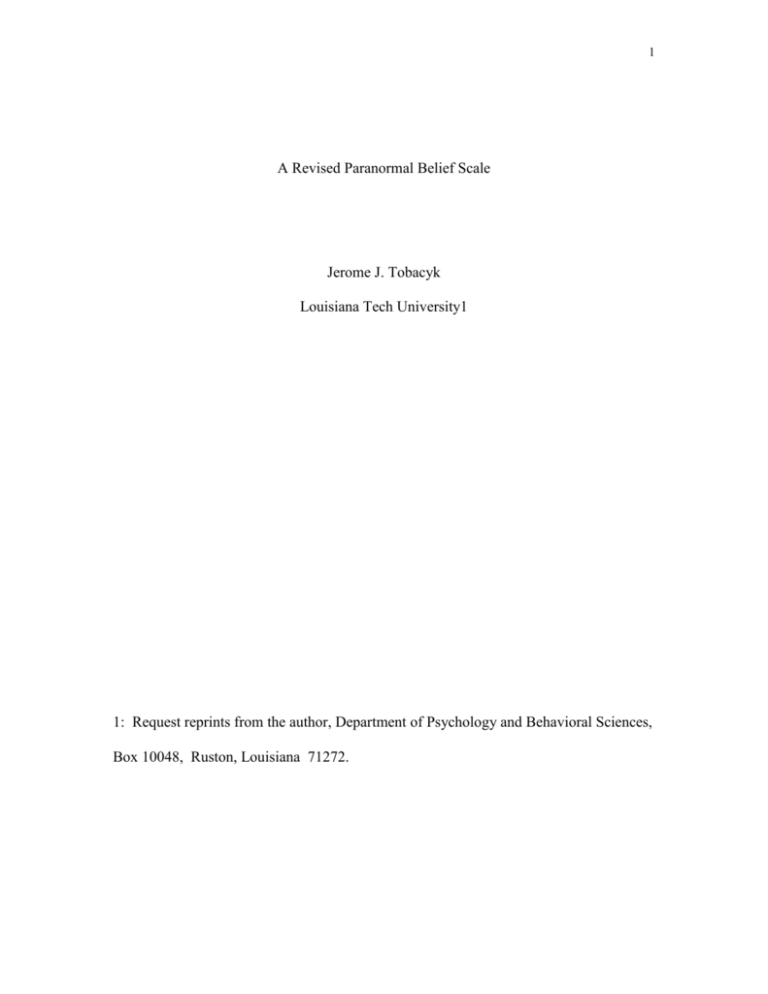
1 A Revised Paranormal Belief Scale Jerome J. Tobacyk Louisiana Tech University1 1: Request reprints from the author, Department of Psychology and Behavioral Sciences, Box 10048, Ruston, Louisiana 71272. 2 Abstract A 26 item Revised Paranormal Belief Scale is introduced which provides a measure of degree of belief in each of seven dimensions: Traditional Religious Belief, Psi, Witchcraft, Superstition, Spiritualism, Extraordinary Life Forms, and Precognition. Improvements from the original 25 item Paranormal Belief Scale include adoption of a seven-point rating scale, as well as item changes for the Precognition, Witchcraft and Extraordinary Life Forms Subscales. These improvements resulted in greater reliability and validity, less restriction of range, and greater cross-cultural validity in Western cultures. 3 A Revised Paranormal Belief Scale The Paranormal Belief Scale (Tobacyk & Milford, 1983) is a widely used measure of degree of belief in paranormal phenomena. Considerable evidence supports the reliability and discriminant validity of the subscales (Tobacyk, 1983a; 1983b; Tobacyk, 1984a; 1984b; Tobacyk & Jones, 1984; Tobacyk & Milford, 1984; Tobacyk, 1985a; Tobacyk, 1985b; Tobacyk & Mitchell, 1987a; 1987b; Tobacyk, Nagot, & Miller, 1987; Tobacyk et al., 1987; Tobacyk, 1988). Paranormal phenomena are defined as those which, if genuine, would violate basic limiting principles of science (Broad, 1953). An example of a basic limiting principle may be: It is unlikely that a mental event can directly affect a physical event except for one in the experient’s own brain. Thus psychosomatic and hypnotically induced phenomena are not paranormal, but ostensible psychokinesis or witchcraft would be. The paranormal Belief Scale provides a separate score on each of seven factorially derived subscales - with each subscale reflecting a major dimension of paranormal belief. These subscales are: Traditional Religious Belief, Psi, Witchcraft, Superstition, Spiritualism, Extraordinary Life Forms, and Precognition. Respondents indicate degree of belief for each of 25 items by using a five-point rating scale. Although the original Paranormal Belief Scale shows satisfactory reliability and validity, this article reports construction of a Revised Paranormal Belief Scale with changes in the rating scale and in item content for three subscales. More specifically, these changes involve: (1) use of a seven-point rating scale, (2) construction of a new Precognition subscale, (3) replacement of two of four Witchcraft Subscale items, and (4) 4 replacement of one of three Extraordinary Life Forms subscale items. These changes were made to lessen restriction in range and to improve subscale reliability and validity, particularly cross-cultural validity. Seven-point rating scale Some restriction in range occurred on the original Paranormal Belief Scale, particularly on the Traditional Religious Belief and Superstition subscales. To reduce restriction in range, a seven-point rating scale is used with the Revised Paranormal Belief Scale. Table 1 lists the means, standard deviations, and maximum and minimum scores Insert Table 1 About Here for both the original and the Revised Paranormal Belief Scales. As indicated in Table 1, the minimum and maximum scores on the Revised Paranormal Belief subscales indicate that respondents generally use the full seven-point rating scale. Also, as indicated in Table 1, the standard deviations have approximately doubled for these subscales: Traditional Religious Belief, Psi, Witchcraft, and Spiritualism. This seven-point rating scale allows respondents to more precisely describe their beliefs, and will lessen restriction of range. Precognition subscale The original Precognition subscale has the lowest test-retest reliability of the seven original subscales (rtt + .60 over a four-week interval). The three Precognition subscale items are: Item 1 – Dreams can provide information about the future; Item 2 – Some people have the ability to predict the future; and Item 3 – The idea of predicting the future is foolish. Each of these items is ambiguous and could be endorsed for reasons that do or do not reflect belief in paranormal precognition. 5 For example, regarding Item 1, a dream could provide accurate information about the future simply due to coincidence or through normal cognitive processes (e.g. “remembering” the location of a lost object in a dream). Thus, endorsement of Item 1 might or might not reflect belief in paranormal precognition. Concerning Item 2, trained scientist (e.g. meteorologists, medical diagnosticians) use scientifically validated procedures to predict future events. Thus, endorsement of Item 2 might reflect either belief in paranormal precognition or belief in the accuracy of predictions made by such prognosticators as medical diagnosticians or meteorologists. Item 3 is also ambiguous. For example, are all human attempts at predicting the future foolish, including such behaviors as career preparation or purchasing insurance policies? Alternatively, Item 3 could be construed as meaning that only paranormal methods of predicting the future are foolish. In a study of the cognitive dimensions used in predicting future events (Tobacyk & Nagot, 1987), 349 college students rated 60 beliefs about predicting future events. The sixty items were intercorrelated and factor analyzed, revealing seven basic dimensions used to predict future events. The two clearest marker items were selected from each of the two largest paranormal precognition dimensions to form a new Precognition subscale. These dimensions and items were: Paranormal Divinatory Systems (Astrology is a way to accurately predict the future. The horoscope accurately tells a person’s future.) and Psychically Gifted Persons (Some psychics can accurately predict the future. Some people have an unexplained ability to predict the future.). The three original Precognition items were replaced by these four new Precognition items. The test-retest reliability of this revised Precognition subscale over a four-week interval is .81, for forty college 6 students, a substantial improvement over the reliability of the original Precognition subscale (r tt = .60). Witchcraft and Extraordinary Life Forms subscales Changes were made in the Witchcraft and Extraordinary Life Forms subscales to improve cross-cultural validity in Western cultures. Research with the original Paranormal Belief Scale in Finland, Germany, and Poland, showed that many European respondents were unfamiliar with such ostensibly paranormal phenomena as voodoo or Bigfoot. Therefore, on the Witchcraft subscale, the two items concerning belief in voodoo (Voodoo is a real method to use paranormal powers. There are actual cases of voodoo death.) were replaced with two items which more generally concerned witchcraft (Through the use of formulas and incantations, it is possible to cast spells on persons. There are actual cases of witchcraft.) It is noted that the two replacement Witchcraft subscale items were marker variables defining the Witchcraft factor in the original factor analytic study for the Paranormal Belief Scale (Tobacyk & Milford, 1983). The factor loadings for the two original items, respectively .68 and .55. The test-retest reliability of the revised Witchcraft subscale is .93 over a four-week interval, while that of the original Witchcraft subscale was .69. Also to improve cross-cultural validity, the item “Bigfoot does exist” from the original Extraordinary Life Forms subscale was replaced by the item “There is life on other planets”. Although the item “Bigfoot does exist” had a stronger factor loading than the replacement item in the original factor analytic study (.74 versus .41), the new item was also a marker variable for the Extraordinary Life Forms factor. This change was necessary because familiarity with the Bigfoot phenomena appears limited to the United 7 States. The revised Extraordinary Life Forms subscale has a four-week test-retest reliability of .91, compared to .82 for the original subscale. It is noted that Extraordinary Life Forms is the only belief dimension which does not strictly conform to the “basic limiting principle” definition of paranormality. However, belief in extraordinary life forms is often considered a component of a more general paranormal or occult ideology (Zusne & Jones, 1982). Revised Paranormal Belief Scale items The remaining 18 items from the original Paranormal Belief Scale were retained in the Revised Paranormal Belief Scale. The four-week test-retest reliabilities for the Insert Table 2 About Here remaining subscales on a forty-subject university student sample are: Full Scale .92, Traditional Religious Belief .95, Psi .71, Superstition .89, and Spiritualism .91. Summary In summary the original 25 item five-point Paranormal Belief Scale was modified into a 26 item seven-point Revised Paranormal Belief Scale. The changes include replacement of the original three-item Precognition subscale, replacement of two of the four original Witchcraft subscale items, and replacement of one of the three original Extraordinary Life Forms subscale items. A total of six original items were replaced by seven new items. These changes will improve reliability and validity, reduce restrictions in range, and increase the cross-cultural validity of the Paranormal Belief Scale in Western cultures. It is recommended that the revised scale be used in future research on paranormal beliefs. 8 Table 1 A comparison of norms on the Original and Revised Paranormal Belief for university students in the Southern United States. Original Paranormal Belief Scale (n=460) Full Scale M 72.9 Revised Paranormal Belief Scale (n=217) SD Min 11.1 41 Max 104 M SD Min 89.1 21.9 40 Max 165 Subscales Traditional Religious Belief 4.5 0.6 1.0 5.0 6.3 1.2 1.0 7.0 Psi 2.8 0.7 1.0 5.0 3.1 1.5 1.0 7.0 Witchcraft 2.5 0.8 1.0 5.0 3.4 1.7 1.0 7.0 Superstition 1.7 0.7 1.0 4.0 1.6 1.2 1.0 7.0 Spiritualism 2.4 0.7 1.0 5.0 2.8 1.4 1.0 7.0 Extraordinary Life Forms 2.4 0.8 1.0 5.0 3.3 1.3 1.0 7.0 Precognition 3.5 0.7 1.0 5.0 3.0 1.3 1.0 7.0 9 Table 2 Revised Paranormal Belief Scale Please put a number next to each item to indicate how much you agree or disagree with that item. Use the numbers as indicated below. There are no right or wrong answers. This is a sample of your own beliefs and attitudes. Thank you. 1=Strongly Disagree 2=Moderately Disagree 3=Slightly Disagree 4=Uncertain 5=Slightly Agree 6=Moderately Agree 7=Strongly Agree 1. 2. 3. 4. 5. 6. 7. 8. 9. 10. 11. 12. 13. 14. 15. 16. 17. The soul continues to exist though the body may die. Some individuals are able to levitate (lift) objects through mental forces. Black magic really exists. Black cats can bring bad luck. Your mind or soul can leave your body and travel (astral projection). The abominable snowman of Tibet exists. Astrology is a way to accurately predict the future. There is a devil. Psychokinesis, the movement of objects through psychic powers, does exist. Witches do exist. If you break a mirror, you will have bad luck. During altered states, such as sleep or trances, the spirit can leave the body. The Loch Ness monster of Scotland exists. The horoscope accurately tells a person’s future. I believe in God A person’s thoughts can influence the movement of a physical object. Through the use of formulas and incantations, it is possible to cast spells on persons. 18. The number “13” is unlucky. 19. Reincarnation does occur. 20. There is life on other planets. 21. Some psychics can accurately predict the future. 22. There is a heaven and a hell. 23. Mind reading is not possible 24. There are actual cases of witchcraft. 25. It is possible to communicate with the dead. 26. Some people have an unexplained ability to predict the future. Note: Item 23 is reversed for scoring. Traditional Religious Belief = Mean Items (1, 8, 15, 22) Psi = Mean Items (2, 9, 16, 23) Witchcraft = Mean Items (3, 10, 17, 24) Superstition = Mean Items (4, 11, 18)] Spiritualism = Mean Items (5, 12, 19, 25) Extraordinary Life Forms = Mean Items (6, 13, 20) Precognition = Mean Items (7, 14, 21, 26) 10 References Broad, C. D. (1953). The relevance of psychical research to philosophy. In J. Ludwig (Ed.), Philosophy and parapsychology. (pp.43 – 63). Buffalo: Prometheus. Tobacyk, J. (1983). Paranormal beliefs, interpersonal trust and social interest. Psychological Reports. 53, 229 – 230. Tobacyk, J. & Milford G. (1983). Belief in paranormal phenomena: Assessment instrument development and implications for personality functioning. Journal of Personality and Social Psychology. 44, 648 – 655. Tobacyk, J. (1984a). Death threat, death concerns and paranormal belief. In F. R. Epting & R. A. Neimeyer (Eds.), Personal meanings of death. (pp. 29 – 38). New York: Hemisphere. Tobacyk, J. (1984b). Paranormal belief and college grade point average. Psychological Reports. 54, 217 – 218. Tobacyk, J. & Jones, G. (1984). Paranormal beliefs of high school students. Psychological Reports. 55, 255 – 261. Tobacyk, J. & Milord, G. (1984). Superstition and intensionality. Psychological Reports. 55, 513 – 514. Tobacyk, J. (1985a). Paranormal beliefs, alienation, and anomie in college students. Psychological Reports. 57, 844 – 846. Tobacyk, J. (1985b). The paranormal belief scale and social desirability. Psychological Reports. 57, 624. 11 Tobacyk, J. & Mitchell, T. (1987a). Out-of-body experience status as a moderator of effects of narcissism on paranormal beliefs. Psychological Reports. 60, 440 – 442. Tobacyk, J. & Mitchell, T. (1987b). The out-of-body experience and personality adjustment. Journal of Nervous and Mental Disease. 175(6), 367 – 370. Tobacyk, J., Nagot, E., & Miller, M. (1987). Paranormal beliefs and locus of control: A multidimensional examination. Journal of Personality Assessment (in press). Zusne, L. & Jones, W. H. (1982). Anomalistic psychology. Erlbaum: Hillsdale, N. J. 12 QUESTIONNAIRE – RI Please put a number next to each item to indicate how much you agree or disagree with that item. Use the numbers as indicated below. There are no right or wrong answers. This is just a sample of your own beliefs and attitudes. Thank you. 1 = Strongly Disagree 2 = Moderately Disagree 3 = Slightly Disagree 4 = Uncertain 5 = Slightly Agree 6 = Moderately Agree 7 = Strongly Agree _____ _____ _____ _____ _____ _____ _____ _____ _____ 1. 2. 3. 4. 5. 6. 7. 8. 9. _____ 10. _____ 11. _____ 12. _____ _____ _____ _____ _____ 13. 14. 15. 16. 17. _____ _____ _____ _____ _____ _____ _____ _____ _____ 18. 19. 20. 21. 22. 23. 24. 25. 26. The soul continues to exist though the body may die. Some individuals are able to levitate (lift) objects through mental forces. Black magic really exists. Black cats can bring bad luck. Your mind or soul can leave your body and travel (astral projection). The abominable snowman of Tibet exists. Astrology is a way to accurately predict the future. There is a devil. Psychokinesis, the movement of objects through psychic powers, does exist. Witches do exist. If you break a mirror, you will have bad luck. During altered states, such as sleep or trances, the spirit can leave the body. The Loch Ness monster of Scotland exists. The horoscope accurately tells a person’s future. I believe in God. A person’s thoughts can influence the movement of a physical object. Through the use of formulas and incantations, it is possible to cast spells on persons. The number “13” is unlucky. Reincarnation does occur. There is life on other planets. Some psychics can accurately predict the future. There is a Heaven and a Hell. Mind reading is not possible. There are actual cases of witchcraft. It is possible to communicate with the dead. Some people have an unexplained ability to accurately predict the future. 13 Sex ________ Age _________ Classification: Fr. Soph. Jr. Sr. Major: ______________________ GPA _______ Race: Black White Other Number of older brothers _______ Number of older sisters _______ Number of younger brothers ________ Number of younger sisters _______ Have you ever had an experience in which you felt that “you” were located “outside of” or “away from” your physical body; that is, the feeling that your consciousness, mind, or center of awareness was at a different place than your physical body? (If in doubt, please answer “NO”). YES _______ NO ________ If you answered “YES” to the above question then, How many times have you had this experience? _______________________________ How many times have you “left your body” by choice, that is, on purpose?____________________________________________________________
